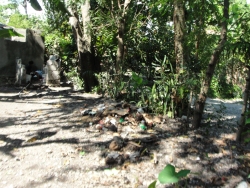 |
Contact usUnited CaribbeanHaiti Child CareEmpowerment Programs
Ecological ReforestationGospel Tourism |
home>> haiti
child sponsorship>>aquaponics
Aquaponics Aquaponics is a technology that combines aquaculture (fish farming) with hydroponics (growing plants without soil). The Problem: 1. Fish farms have a problem with waste disposal because the fish constantly excrete ammonia into the water. Ammonia is an irritating chemical that most of us associate with window cleaners. The usual way to remove ammonia from water is to filter or discard the wastewater periodically to prevent the toxic waste products from building up and killing the fish. However in Haiti, filters are expensive and water is often a precious resource. 2. Hydroponics requires farmers to purchase expensive fertilizer which is a challenge in Haiti. The Solution: In an aquaponics system both of these problems are solved. The water is treated with beneficial bacteria that constantly converts the toxic ammonia into a natural plant fertilizer. The water is then circulated between plant growing beds and the fish tanks. This allows the fish to provide food for plants and the plants to purify water for the fish tanks. This creates a natural ecosystem where both plants and fish thrive. Aquaponics is an innovative solution to the fish farmer's need to dispose of fish waste and the hydroponic grower's need for nutrient-rich water. Research has demonstrated that this technology can increase crop yields by 10 - 45 fold when compared to traditional soil planting and it uses only 10% of the water needed for traditional soil agriculture, Although the practices of fish farming and soil-less plant culture have been traced to ancient times, the combination of the two is quite new and we believe can solve the problems associated with normal fish farming. Hydroponics: Hydroponics is a method of growing plants using mineral nutrient solutions, in water, without soil. Some of the reasons why hydroponics is being adapted around the world for food production are the following:
The Fish Farm in conjunction with poultry farming. The droppings of birds from the Poultry Project can be utilized to fertilize the pond. Poultry litter recycled into fish pond produces 4,500 – 5,000kg fish per hectare pond per year. The poultry litter is applied to the pond in daily doses of a rate of 40 – 50 kg per hectare. The application of litter may be deferred during the days when algai blooms appear in the pond. 500 chickens would be able to provide sufficient manure for fertilization of one hectare of fish pond. |
| Copyright © 2024 www.UnitedCaribbean.com. All rights reserved. Disclaimer Click to Contact us |
















































